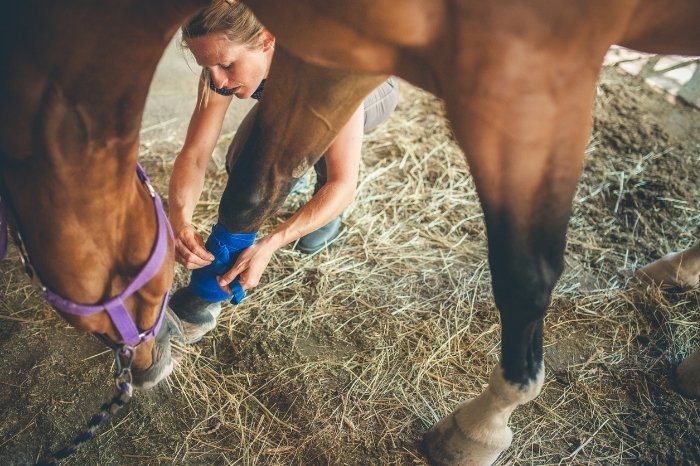Last Updated on January 12, 2023
If you’re looking for an effective horse scratches treatment recipe, we’ve got the perfect formula right here for you! Today we’re going to help you create a versatile homemade recipe for treating scratches on horses which is super simple to prepare.
This means that the next time your horse gets a bout of scratches, there is no need to panic! You can put together this recipe in just a few minutes, and it takes very little skill to prepare.
So, here is our ultimate guide to the best and most effective horse scratches treatment recipe!
What Is Horse Scratch Treatment?
If your horse is prone to itchy skin or tends to scratch itself on any available object, you will be familiar with horse skin infection treatments such as Coats Aloe Liniment. Many horses get a condition called pastern dermatitis in the winter months, more commonly known as mud fever or scratches.
As with all equine medical problems, it is important to seek expert veterinary advice before deciding on a treatment plan. Applying the wrong treatment may make the condition worse, causing your horse more pain in the long term.
The aim of a good horse scratches treatment is to help to soothe the skin and promote healing, as well as reduce pain and itchiness. Scratches are caused by prolonged exposure to wet, muddy conditions, so you will also need to move the horse to a clean dry area to help resolve the problem.
Take Out Time to Also Read:
- Can A Horse Give Birth To A Pony? – The Truth!
- How Often Do Horses Need Their Teeth Floated And Why Do They Need This?
What Does It Mean For A Horse To Scratch?
Horses are just like humans, and will scratch at areas of skin that are itchy or sore. They do this to relieve irritation, but unfortunately by scratching they may often make the problem worse.
A horse can scratch itself in a range of different ways. They can use their teeth to nibble at areas of the body they can reach, or may extend a hoof to scratch at difficult areas such as behind the ears. Horses will also scratch themselves by rubbing on solid objects such as fence posts, tree trunks, and stable doors.
The term ‘scratches’ is also used to describe a condition called pastern dermatitis, also known as mud fever or greasy heels. This is not caused by the horse scratching itself, but occurs when the horse lives in damp, wet conditions.
Can You Ride A Horse With Scratches?
You can ride a horse with scratches as long as it is not showing signs of lameness, pain or discomfort. It is important to make sure that the tack does not rub on any affected areas, and must make sure to clean and dry the horse’s legs thoroughly after your ride.

What You Will Need To Make The Best Horse Scratches Treatment Recipe
The great thing about making your own horse scratch treatment is that the ingredients are easy to get hold of, and you don’t need any specialized equipment!
Let’s take a look at what you’ll need:
Ingredients
- Antibacterial soap, such as Betadine or Hibiscrub.
- A suitable barrier cream, such as petroleum jelly or nappy rash cream.
It is important to note that your veterinarian may prescribe other medicated barrier creams for scratches, which need to be used in a different way than the method outlined below. Our recipe and method involve the steps that should be followed for a mild case of scratches, but it is important to assess the response to treatment carefully and seek further veterinary advice if necessary.
Equipment
- Blunt-ended scissors or trimming clippers
- A bowl of clean, warm water
- Cotton wool
- Clean towel
- Disposable gloves
Step By Step Instructions
Now you’ve got your ingredients and equipment together, simply follow this easy guide to making our great horse scratches treatment recipe:
Step 1: Remove Hair
Using the scissors or clippers, carefully remove excess hair from the affected area.
Bickmore Gall Salve Wound Cream For Horses 14oz
Step 2: Cleanse The Affected Area With An Antibacterial Solution
Add a couple of drops of antibacterial soap to the water. Using cotton wool, gently cleanse the affected area, removing any loose scabs. The more scabs you can remove the first time you do this, the higher the chance of a rapid resolution to the problem.
Step 3: Dry The Legs
Thoroughly dry the legs by carefully patting them with a towel. This make take some time, so be patient!
Step 4: Apply Barrier Cream
Wearing clean gloves, apply a layer of barrier cream over the entire affected area, as well as the surrounding skin surface. Take care not to contaminate the barrier cream with dirty gloves – use a spoon or spatula to ladle it out if necessary.
Step 5: Repeat Daily
Repeat this process once or twice daily for up to 7 days.
Tips And Tricks For Making An Effective Horse Scratches Treatment Recipe
A good-quality horse scratch treatment will be the right thickness to stay on the affected area, but not so thick that it cannot be spread easily. You should be able to wipe it away without much effort when cleaning the affected area.
It is vital to ensure that any ingredients in a horse scratch treatment recipe are non-toxic and that they will not cause any detrimental side effects. It is also important to treat the underlying cause of any itching or soreness, otherwise, the horse will continue to scratch no matter what lotions or potions you apply.
Click Here to Get Info About:
Servings And Preparation Time
Be prepared to take your time when treating scratches on a horse – the more effort you put into removing scabs and dirt and then thoroughly drying the legs, the higher the chances of a faster resolution to the problem. Inadequate cleaning or failure to dry the legs properly may make the scratches worse rather than better.

Conclusion – Horse Scratches Treatment Recipe
If you want to soothe your horse sore legs, this method is a great place to start. The steps involved are perfect for battling the source of the infection, as well as promoting skin healing and reducing inflammation. And best of all, it is really easy to carry out and requires very few ingredients!
Did you find this recipe for horse scratch treatment useful? If so, please share your thoughts in the comments down below and share this article if you enjoyed it.

Kate Chalmers is a qualified veterinary nurse who has specialized in horse care for the vast majority of her career. She has been around horses since she was a child, starting out riding ponies and helping out at the local stables before going on to college to study Horse Care & Management. She has backed and trained many horses during her lifetime and competed in various equestrian sports at different levels.
After Kate qualified as a veterinary nurse, she provided nursing care to the patients of a large equine veterinary hospital for many years. She then went on to teach horse care and veterinary nursing at one of the top colleges in the country. This has led to an in-depth knowledge of the care needs of horses and their various medical ailments, as well as a life-long passion for educating horse owners on how to provide the best possible care for their four-legged friends.
Kate Chalmers BSc (Hons) CVN, Dip AVN (Equine) Dip HE CVN EVN VN A1 PGCE

